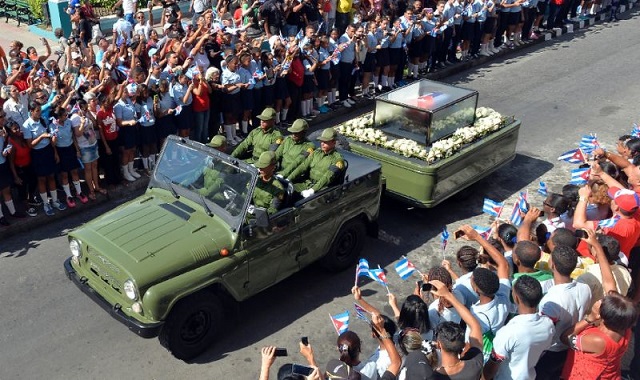
Santiago de Cuba, Cuba | AFP |
The convoy carrying the ashes of Cuba’s late communist leader Fidel Castro capped an island-wide journey on Saturday, reaching the cradle of his revolution for a final rally before burial.
Tens of thousands of people cheered as the olive-green jeep that has pulled the cedar urn with Castro’s remains across Cuba since Wednesday rolled into Santiago de Cuba.
The ashes were paraded across the eastern city, stopping in front of a balcony where Castro gave a speech following his revolution’s triumph in 1959.
Like other crowds along the four-day, 900-kilometer (560-mile) trip from Havana, this one chanted “I am Fidel!” after a series of Castro speeches played on a giant screen.
The caravan passed in front of the Moncada barracks — scene of his first armed uprising in 1953 — and headed to Revolution Square for an evening rally.
President Raul Castro, who took over when his brother fell ill in 2006, will deliver a much-awaited speech during the massive tribute with foreign dignitaries, ranging from presidents to Argentine football legend Diego Maradona, who called Castro his “second father.”
After a nine-day mourning period, the remains will be interred on Sunday during a private ceremony at the Santa Ifigenia cemetery, where the 19th-century independence hero Jose Marti is buried.
Castro’s death on November 25 at age 90 has fueled discussions about his divisive legacy and the direction the country may take without the omnipresent leader, who ruled for almost half a century.
Tearful supporters have cheered him for the free education and health care he developed on the island, while detractors call him a brutal dictator who imprisoned dissidents and ran the economy to the ground.
After Fidel is laid to rest, all eyes will turn to Raul Castro’s next move. He has implemented modest economic reforms, vowed to step down in 2018 and restored diplomatic ties with the United States.-
‘Eternal comandante’
Castro has been hailed in almost religious terms since his death, with the communist party newspaper Granma calling him the “eternal comandante.”
Children in school uniform, veterans in military fatigues and entire families waved Cuba’s flags and chanted “Fidel!” as the ashes arrived in Santiago.
“He has been the father of all Cubans and all the people in need in the world,” said Margarita Aguilera, the 54-year-old director of a state tobacco company who painted the words “farewell, comandante” on a white stone in front of a house.
The government had already led a huge rally with two dozen foreign presidents in Havana on Tuesday, but Santiago holds a special place in Castro’s life.
“This is the cradle. Everything started here,” said Victor Rivera Coca, 52, a cook who came from the town of Las Tunas, three hours away by car, with his wife and three-year-old son.
On July 26, 1953, the Castro brothers launched a failed attack on the Moncada military barracks in Santiago.
Although the rebels were jailed, the attack put Castro on the map and he would eventually go into exile in Mexico.
“History will absolve me,” the trained lawyer famously said at his trial.
Dissidents lie low
Three years after the Moncada defeat, the Castro brothers and their band of bearded rebels returned to Cuba aboard a ship named Granma. On Friday, Cuba marked 60 years since the yacht landed in a southeastern beach.
The rebels fled into the Sierra Maestra mountains, launching a guerrilla war that would end in triumph against the US-backed dictator Fulgencio Batista on January 1, 1959.
Following their victory, Castro celebrated by touring the island from Santiago to Havana. This week’s “caravan of freedom” took his ashes on the reverse route.
While hundreds of thousands of people have gathered along the road to bid farewell, the government has encouraged Cubans to sign a pledge to defend his revolution.
Meanwhile, dissidents have kept a low profile during the commemorations, calling off regular protests, although they plan to resume their demonstrations after Castro’s burial.
 The Independent Uganda: You get the Truth we Pay the Price
The Independent Uganda: You get the Truth we Pay the Price



